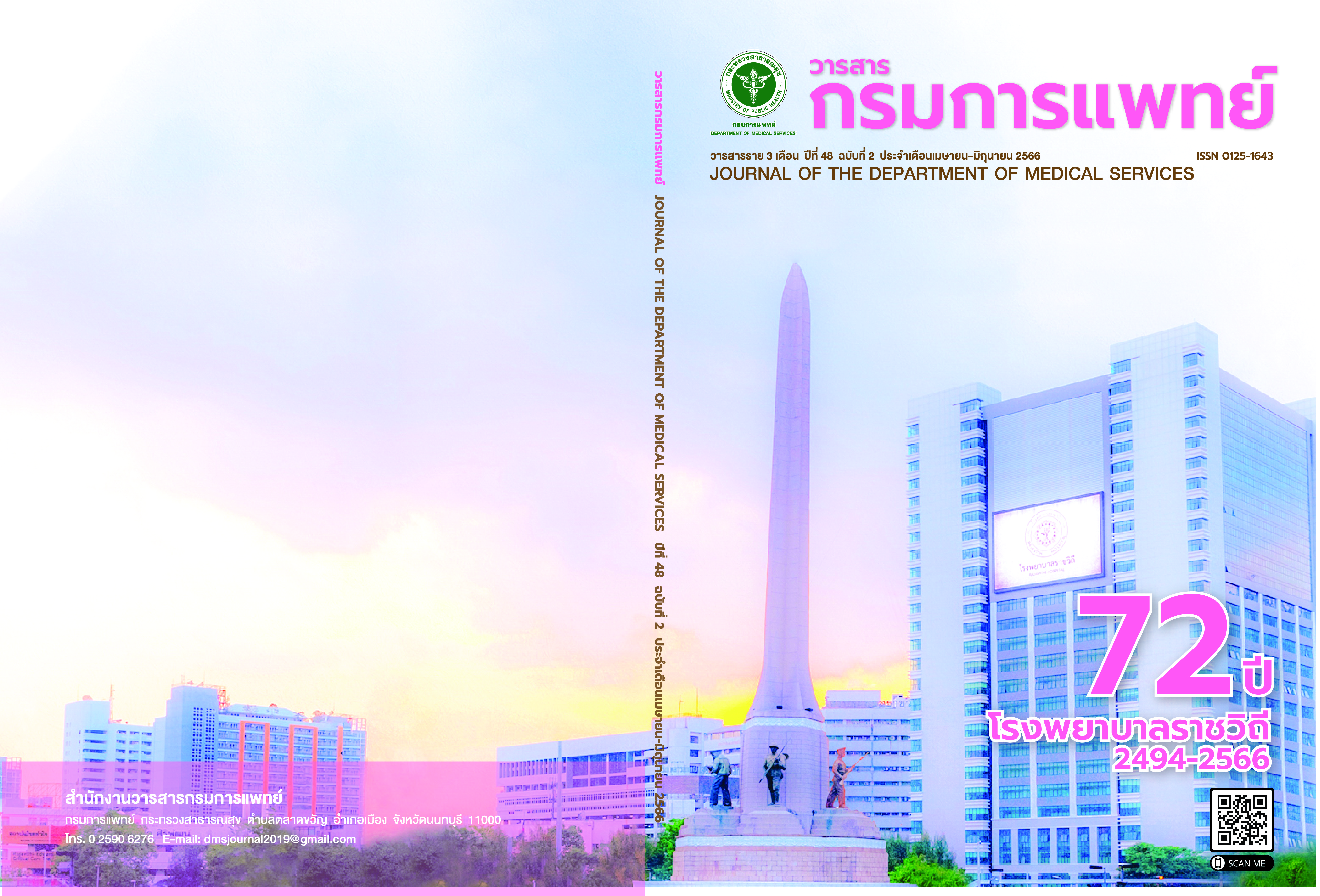Radiation Dose Assessment from Computed Tomography and Endovascular Treatment of Acute Ischemic Stroke Patients
DOI:
https://doi.org/10.14456/jdms.2023.30Keywords:
Acute ischemic stroke, Effective dose, Endovascular treatment, CancerAbstract
Background: Several treatments are available for acute ischemic stroke. Endovascular treatment is a commonly used method at the Neurological Institute of Thailand. Therefore, this group of patients undergoes radiation exposure from Computed Tomography or CT and Digital Subtraction Angiography or DSA procedures. Objectives: This study aimed to determine the radiation dose received by patients undergoing CT in combination with endovascular treatment and to assess the risk to patients. Method: The effective dose was calculated using conversion factors of 61 acute ischemic stroke patients treated with endovascular treatment between October 1, 2019, and October 1, 2020. The data were retrospectively collected from CT and DSA machines. Results: The study included patients diagnosed with acute ischemic stroke and treated with endovascular treatment, which were 28 females (45.9%)and 33 males (54.1%) aged between 40 - 89 years old, with a mean age of 64 years old. In terms of CT, the mean volumetric computed tomography index was 40.71±13.88 mGy and the mean dose-length product was 1938±638 mGycm. As for endovascular treatment, the mean air KERMA was 242 ± 229 mGy with the mean dose area product of 6192.3±4322.3 µGycm2, and the mean fluoroscopy time was 22±16 minutes. The mean effective dose from computed tomography was 4.45±1.92 mSv (range 1.65-10.67 mSv), and 2.48±1.73 mSv was from endovascular treatment. The total effective dose for patients had a mean of 6.94±2.69 mSv. Conclusion: Acute ischemic stroke patients exposed to radiation from CT and endovascular treatment are at a very low additional risk of death from cancer. The risk is 1 in 10,000 compared to the mean effective dose of 6.94 mSv. In addition, the risk is 1 in 1,000 compared to the maximum effective dose of 13.73 mSv.
References
Donnan GA, Fisher M, Macleod M, Davis SM. Stroke. Lancet 2008;371(9624):1612-23.
Worakijthamrongchai T. Endovascular Treatment in AcuteIschemic Stroke. J Thai Stroke Soc 2017; 16(3):5-13.
Mccollough C, Cody D, Edyvean S, Geise R, Gould B, Keat N,et al. The Measurement, Reporting, and Management ofRadiation Dose in CT. American Association of Physicists inMedicine 2008; 96:11-3.
Shrimpton PC, Jansen JTM, Harrison JD. Updated estimatesof typical effective doses for common CT examinations inthe UK following the 2011 national review. Br J Radiol 2016;89(1057):20150346.
Hart D, Jones DG, Wall BF. Estimation of effective dose indiagnostic radiology from entrance dose and dose-areaproduct measurement (NRPBR262). Chilton, England: NationalRadiological Protection Board; 1994.
Mahesh M. Fluoroscopy: patient radiation exposureissues. Radiographics 2001; 21(4):1033-45.
Abul-Kasim K, Gunnarsson M, Maly P, Ohlin A, Sundgren P.Radiation Dose Optimization in CT Planning of CorrectiveScoliosis Surgery. A Phantom Study. Neuroradiol J 2008;21(3):374-82.
Jessen KA, Bongartz G, Geleijns J, Golding SJ, Panzer W,Jurik AG, et al. European guidelines on quality criteria forcomputed tomography, 16262EN. European Community; 2000.
Shrimpton PC, Hillier MC, Lewis MA, Dunn M. National survey ofdoses from CT in the UK: 2003. Br J Radiol 2006; 79(948):968-80.
Treier R, Aroua A, Verdun FR, Samara E, Stuessi A, Trueb PR.Patient doses in CT examinations in Switzerland: implementationof national diagnostic reference levels. Radiat Prot Dosimetry2010; 142(2-4):244-54.
Foley SJ, McEntee MF, Rainford LA. Establishment of CT diagnosticreference levels in Ireland. Br J Radiol 2012; 85(1018):1390-7.
van der Molen AJ, Schilham A, Stoop P, Prokop M, Geleijns J.A national survey on radiation dose in CT in The Netherlands.Insights Imaging 2013;4(3):383-90.
Wongsanon W, Phaorod J, Hanpanich P, Awikunprasert P. Studysurvey of Dose-Length Product from Computed TomographyExamination in Srinagarind Hospital, Khon Kaen University.SRIMEDJ 2020; 35(4):433-7.
Japan Association on Radiological Protection in Medicine, JapanAssociation of Radiological Technologists, Japan Network forResearch and Information on Medical Exposure (J-RIME), JapanRadiological Society, Japan Society of Medical Physics, JapaneseRadiation Research Society, et al. Diagnostic reference levelsbased on latest surveys in Japan—Japan DRLs 2015—. [internet]2016. [Cited 12 Oct 2020] Available from URL:https://www.radher.jp/J-RIME/report/DRLhoukokusyoEng.pdf.
Donmoon T, Chusin T. Establishment of local diagnosticreference levels for commonly performed computedtomography examinations in Thai cancer hospitals. Thai J RadTech 2021; 46(1):35-2.
Hassan AE, Amelot S. Radiation Exposure duringNeurointerventional Procedures in Modern Biplane AngiographicSystems: A Single-Site Experience. Interv Neurol 2017; 6(3-4):105-16.
Farah J, Rouchaud A, Henry T, Regen C, Mihalea C, Moret J,et al. Dose reference levels and clinical determinants in strokeneuroradiology interventions. Eur Radiol 2019; 29(2):645-53.
Friedrich B, Maegerlein C, Lobsien D, Mönch S, Berndt M,Hedderich D, et al. Endovascular Stroke Treatment on SinglePlane vs. Bi-Plane Angiography Suites : Technical Considerationsand Evaluation of Treatment Success. Clin Neuroradiol 2019;29(2):303-9.
Bärenfänger F, Block A, Rohde S. Investigation of RadiationExposure of Patients with Acute Ischemic Stroke duringMechanical Thrombectomy. Rofo 2019; 191(12):1099-106.
Weyland CS, Seker F, Potreck A, Hametner C, Ringleb PA,Möhlenbruch MA, et al. Radiation exposure per thrombectomyattempt in modern endovascular stroke treatment in the anteriorcirculation. Eur Radiol 2020;30:5039-47.
Verdun FR, Bochud F, Gundinchet F, Aroua A, Schnyder P,Meuli R. Quality initiatives* radiation risk: what you shouldknow to tell your patient. Radiographics 2008; 28(9):1807-16.
US National Academy of Sciences, National Research Council,Committee to Assess Health Risks from Exposure to Low Levelsof Ionizing Radiation. Health Risks from Exposure to Low Levelsof Ionizing Radiation. BEIR VII Phase 2. Washington, DC: NationalAcademies Press; 2006.
Martin CJ. Effective dose: how should it be applied to medicalexposures? Br J Radiol 2007; 80(956):639–47.
Downloads
Published
How to Cite
Issue
Section
License
Copyright (c) 2023 Department of Medical Services, Ministry of Public Health

This work is licensed under a Creative Commons Attribution-NonCommercial-NoDerivatives 4.0 International License.
บทความที่ได้รับการตีพิมพ์เป็นลิขสิทธิ์ของกรมการแพทย์ กระทรวงสาธารณสุข
ข้อความและข้อคิดเห็นต่างๆ เป็นของผู้เขียนบทความ ไม่ใช่ความเห็นของกองบรรณาธิการหรือของวารสารกรมการแพทย์



